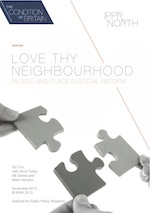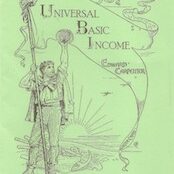PAUL SALTONSTALL reviews a new pamphlet from IPPR which argues that to tackle deep-rooted poverty the state must improve localities.
Love thy Neighbourhood: People and Place in social reform by Anna Turley, Bill Davies and Mark Harrison of the influential Institute for Public Policy Research (IPPR) is an impressive piece of work that makes a series of interesting, but technical, policy proposals to address deprivation. These cover areas such as data collection, political engagement, participative budgeting, housing and green energy. The fundamental argument is that to tackle deep-rooted poverty, the state must improve localities where deprivation is difficult to escape.
 It seems to be proposing the reconstruction of an institutional architecture to bring back Labour’s urban regeneration programmes, even though their success, although significant, was limited and dependent on the performance of the economy.
It seems to be proposing the reconstruction of an institutional architecture to bring back Labour’s urban regeneration programmes, even though their success, although significant, was limited and dependent on the performance of the economy.
It also suggests changes that may reflect practical learning from the New Labour years, such as devolution of funding and direct intervention in the poorest areas, as ways of tackling endemic poverty. There is evidence that the authors have considered the positive (though not unproblematic) aspects of the coalition’s Localism Act 2012 (neighbourhood plan, and so on.) and tried to incorporate those in their thinking.
From an ILP perspective, the pamphlet is of interest because it says that politics needs to realign itself towards local communities. This is welcome and follows on from ‘Blue Labour’, which has some positive things to say about Labour re-establishing itself in the community. As party leader Ed Miliband said, “we need to become a movement again” (the ILP would say, ‘a democratic movement’).
Labour’s inherent electorialism, however, is a barrier to re-rooting the party. I can’t be certain how representative my own experience is, but the focus of Labour’s work in my locality appears to be ‘Labour doorstep’ (or #Labourdoorstep on Twitter), which is a process of voter identification for later targeted marketing purposes.
Instead, the pamphlet imagines a local politics where politicians are at the centre of communities, brokering change through the intricacies of funding streams, public and voluntary sector services that support people in communities. However, that’s not quite the same, it seems to me, as a reborn social movement.
Lacking detail
Unfortunately, the pamphlet does not provide much by way of concrete detail about political re-engagement. This is certainly an aspect that needs much more thought, for it is in danger of being lost amidst the details of other policies.
This contrasts with the pamphlet’s specific recommendations about re-establishing urban regeneration programmes. While there are proposals that would enhance the role of local authorities and community groups, the pamphlet primarily wants to herald the return of the old multi-agency approach that was a mixed blessing under New Labour. There clearly needs to be co-operation between agencies in tackling disadvantage, but there can be a conflict between technocratic arrangements and democratic re-engagement and change. This conflict is not properly acknowledged or explored.
It is odd that the pamphlet does not relate more closely to the thinking about place in another IPPR pamphlet, Everyday Democracy, by Mark Stears, IPPR Associate Fellow and Professor of Political Theory at the University of Oxford, which attempts to revive communitarianism in a more radical and challenging form. It argues that place is important because it encourages co-operation and solidarity. But there is little by way of detailed thinking in Love thy Neighbourhood about how this might be done, although a couple of proposals could be helpful, particularly around community budgeting and assigning the community infrastructure levy to community groups.
There are, perhaps, several issues that this pamphlet raises that are left over from the days of New Labour. The biggest is that the definition of place is too big and indiscriminate, favouring Labour heartlands, but this does not really address poverty as it occurs throughout the country. Deprivation exists everywhere in the UK, often cheek by jowl with affluence.
Indeed, there is plenty of evidence to show that the worst deprivation can occur in the richest places. For example, OFSTED says poor kids often underachieve when they are isolated, often in areas that are more affluent (see: Unseen Children: access and achievement twenty years on).
Some of the poorest areas are isolated communities, without an identifiable community centre, where even the local pubs have closed. Usually, there’s no shortage of good people willing to volunteer, but there’s never been much money to help them because the ward or constituency isn’t deemed to be deprived, even though the ‘place’ or area they live in is. I regret to say this huge policy gap is neither explored nor acknowledged in any detail by the pamphlet.
—-
Love thy Neighbourhood: People and place in social reform, by Anna Turley, Bill Davies and Mark Harrison, is available to download from the IPPR website.


